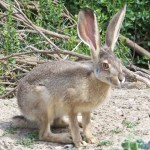
Otters and rabbits and birds—and a lot more—are out on the San Joaquin River National Wildlife Refuge, which until recently was accessible only via the viewing platform near the end of Beckwith Road, west of Modesto. With the recent opening of the Dairy Road entrance just east of River Road in western Stanislaus County, the refuge has a lot more to offer the public.
For one thing, whereas the Beckwith Road viewing platform is best used during the late fall and winter months, when our spectacular wintering waterfowl are present, the Dairy Road facility features year round attractions. Even before leaving their cars, visitors are treated to coveys of California Quail, a bounding circus of rabbits, and a multitude of birds on all sides.
The Refuge is the result of years of painstaking restoration by U.S. Fish and Wildlife field biologists. The goal is to bring back the Valley’s historic wetlands and riparian forests to as faithful a representation of the past as possible. The project includes planting hundreds of thousands of trees, re-introduction of the endangered Riparian Brush Rabbit, and restoration of habitat for former avian residents like Least Bell’s Vireo and Yellow-Billed Cuckoo.
The refuge has already attracted Least Bell’s Vireos, which just a few years ago provided the first recorded Central Valley nesting record in decades. Other birds which greatly declined when riparian and wetland habitat almost disappeared include Least Bittern, Willow Flycatcher, and Yellow Warbler. All are on the road to recovery, with the colorful Yellow Warbler making especially impressive gains.
Many of the Refuge’s summer residents and breeding birds are just arriving from their southern wintering grounds. Among the most spectacular—local equivalents of tropical birds in their colorful feathered finery—are the Black-headed Grosbeaks and Northern Orioles. Both species are clothed in an array of black, orange, and white feathers, each pattern spectacular and definitive of its owner’s identity.
From the path along the north side of Hospital Creek, lucky visitors may get a glimpse of the clown princes of the Refuge, the curious and playful River Otters. In the parking lot and beyond, Jack Rabbits and Cottontails abound. The really fortunate observer may get a glimpse of the threatened but recovering Riparian Brush Rabbit, a tiny lagomorph very similar to the common Cottontail.
Overhead, Swainson’s Hawks, another bird brought back from precarious status by the combined efforts of the Audubon Society and state and federal biologists, are common, as are Red-tailed Hawks, Great Egrets, Double-crested Cormorants and Turkey Vultures.
As the Refuge expands and matures, it will feature what is rapidly becoming the largest contiguous riparian forest in the western United States. The current limited access, with clean restrooms and a nice trail loop, already offers some of the best opportunities for viewing native wildlife anywhere in the Northern San Joaquin Valley.
